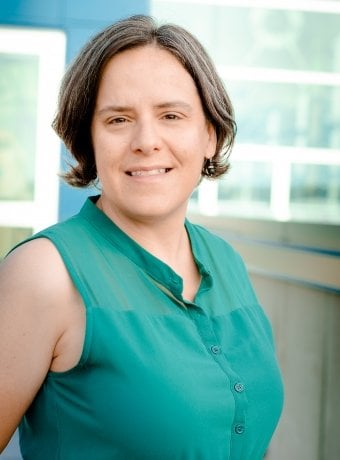After more than a decade of research and collaboration, researchers from Michigan Technological University, Baylor University and Boston University have discovered that inland and coastal aquatic systems play a much larger role in nitrogen fixation and the global nitrogen cycle than their small surface area would suggest.
Amy Marcarelli, Michigan Tech biological sciences professor, is one of three principal investigators on the project, along with Boston U Earth and Environment and Biology Professor Robinson W. Fulweiler and Thad Scott, a Baylor biology professor. The team's research was highlighted in the article "Global importance of nitrogen fixation across inland and coastal waters," recently published in the journal Science.
"The key findings of this project are that nitrogen fixation is ubiquitous across inland and coastal waters," said Marcarelli. "It's an important process in sediments, and these ecosystems contribute more substantially to the global nitrogen budget than we previously thought."
Nitrogen, represented by the letter N on the periodic table of elements, is a colorless and odorless gas essential to life on Earth. Though nitrogen makes up 70% of our atmosphere, it has to be converted into biologically available forms through a process called nitrogen fixation before it can be used by living organisms.
Marcarelli's team determined that despite comprising less than 10% of the planet's surface area, inland and coastal aquatic ecosystems fix an equivalent to 15% of the nitrogen fixed on land and in the open ocean. More than half of that 15% is fixed in lakes, streams and rivers, and wetlands — habitats that have not been included before in global nitrogen budgets.
"This is a substantial change to the global N budget," said Marcarelli. "It suggests that nitrogen fixation contributions in these ecosystems cannot be ignored."

Scientist Demystifies Denitrification
Michigan Tech's Amy Marcarelli, a biological sciences professor who received an National Science Foundation CAREER Award based on her research into denitrification in aquatic ecosystems.
In pre-industrial times, biologically mediated nitrogen fixation was the largest source of nitrogen to ecosystems. This fixation is carried out by specialized microbes and symbionts with an enzyme called nitrogenase. Humans figured out how to fix nitrogen in the laboratory in the early 20th century and industrialized the process in the mid-20th century. Now, humans contribute more nitrogen globally than biological nitrogen fixation each year.
"This excess fixed N has led to widespread pollution of coastal marine and inland aquatic ecosystems, which we, as a field, have hypothesized would decrease biological nitrogen fixation in these habitats," said Marcarelli.
Marcarelli said the project has been a unique experience compared to her other research, in that the team was formed through an application process based on research expertise and relevant skills, with a focus on including people from a range of career stages and countries.
About the Researcher
"Some of us knew each other well," said Marcarelli. "Others were working together for the first time. It's a bit of a leap of faith to build a research team with folks you've never met before, but it also improves the work by including different perspectives and making sure that you're not working in an echo chamber."
The team didn't collect any new data for their analysis. Instead, they gathered existing data on nitrogen fixation in marine and inland aquatic ecosystems. The researchers then reviewed and analyzed the data collaboratively both through team meetings and individual work.
"This led to some interesting challenges and opportunities," said Marcarelli, "But overall it resulted in a product that would have been impossible for one person or lab to complete."
Marcarelli isn't the only Husky who contributed to their report. Alumna Michelle Kelly, who earned her Ph.D. from Michigan Tech in 2024 and currently works as a research scientist in Marcarelli's lab, is also a co-author on the paper, as is Tech biological sciences Ph.D. student Megan Berberich. Marcarelli had one word for how the team is feeling about earning their place in Science: "Elated."
"This is something we've worked toward for so long," said Marcarelli. "It's beyond exciting to know that it's going to reach such a broad audience through this publication."
Marcarelli's focus on nitrogen fixation began in 2008 when, as a Ph.D. student, she co-authored a review paper calling for a reevaluation of N2 fixation contributions to stream ecosystems. Her collaboration with Scott and Fulweiler on nitrogen fixation started with conversations about funding proposals as early as 2013, and she received a five-year $794,661 NSF CAREER Award for her nitrogen fixation research in 2015.
Four years later, in 2019, Marcarelli, Scott and Fulweiler submitted their collaborative proposal to NSF and gained funding in 2020 through the Aquatic Nitrogen Fixation Research Coordination Network (ANF-RCN). The team's RCN award totaled $499,700, of which $252,408 was distributed to Michigan Tech. Work on data synthesis and analysis started in early 2022, and the team began writing their paper for Science later that year. A companion paper containing their global datasets was published online in Limnology and Oceanography Letters in January.
Michigan Technological University is an R1 public research university founded in 1885 in Houghton, and is home to nearly 7,500 students from more than 60 countries around the world. Consistently ranked among the best universities in the country for return on investment, Michigan's flagship technological university offers more than 185 undergraduate and graduate degree programs in science and technology, engineering, computing, forestry, business, health professions, humanities, mathematics, social sciences, and the arts. The rural campus is situated just miles from Lake Superior in Michigan's Upper Peninsula, offering year-round opportunities for outdoor adventure.







Comments